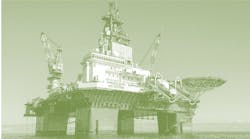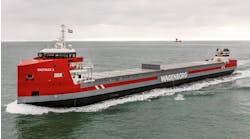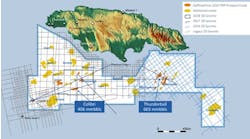Independents driving renewed look at "dead sea" properties on the OCS
Rick Von Flatern
Technology Editor
Older installations and fields are being given new life by technology-driven exploration efforts in fields once thought thoroughly mapped.
New 3D processing capabilities have spawned a new era of prosperity in the Gulf of Mexico, which many operators had given up for dead a few years earlier.During the early 1990s, as much of the US offshore drilling rig fleet was in full retreat from America to points North, South, and Far East, petroleum industry analysts referred to the Gulf of Mexico as the Dead Sea. Operators claimed the Gulf of Mexico (as well as the rest of the US) held no more large, undiscovered hydrocarbon deposits and that they were not so much leaving the US as being expelled by an increasingly hostile business and political climate.
Less than half a decade later, it is obvious reports of the Gulf's death were as exaggerated as the immortality of a huge, price-depressing inventory of natural gas known popularly as the "gas bubble." Drilling rigs are steaming for the Gulf of Mexico. Gulf federal lease sales are bringing the US treasury record sales receipts and Gulf Coast shipyards and fabricators are working to capacity.
The Gulf of Mexico rebirth is the result of a remarkable convergence of events. Besides US federal actions that have created a more hospitable business environment for America's oil industry - including royalty payment relief on deepwater production and more reasonable levels of operator environmental financial liability - many companies have found operations outside the US borders no less difficult than inside them.
Also, by 1995, the oil industry had spent more than 10 years ridding itself of extra fat and a good deal of healthy muscle until only vital organs remained. With no costs left to cut, the industry has turned its collective attention to technological innovation and revolutionary changes in the way it does business, invoking task- and risk-sharing across proprietary lines in ways unthinkable just five years earlier.
The change from cost-cutting to innovation melded with concurrent quantum leaps in 3D seismic processing that made it possible to handle huge amounts of data. Thousands of barrels of bypassed reserves throughout mature regions of the Gulf were exposed while improving the odds of wildcat success from one-in-five to one-in-two.
But many of the new discoveries would have remained untapped without simultaneous technological advances in high-angle drilling, real-time downhole data acquisition, and completion techniques. Coupled with stable, relatively high, oil and gas prices, the new operational technologies have made profitable reserves that would have once been ignored as too small to be economical.
At the same time as science was driving down recovery costs, newly emerging industrial nations were adding steadily to the world's energy demands. As a result, while current oil prices do not approach the levels that followed the OPEC oil embargoes of the 1970s, neither are they as volatile. And as the oil-industry-as-commodity-business has learned, stable prices are better than high prices.
The cumulative effect of these trends is a Gulf of Mexico, and particularly its once-maligned continental shelf, that is the most active theater in the offshore petroleum industry. Major and independent operators with a longtime Gulf presence, newcomers from onshore and outside the US, and start-up companies are making large, long term investments in the Gulf of Mexico. Shipyards and manufacturers, service companies and drilling contractors, are all working to capacity, slowed only by their lack of equipment, space, and a growing, critical skilled labor shortage.
Two strategies, three dimensions
For most companies, activity on the shelf is a two-pronged attack - one to maximize mature fields and one to find and exploit new ones. In both instances, the role of 3D seismic is impossible to overstate.Apache is a longtime explorer and developer on the shelf and has seen the change 3D has brought to Gulf of Mexico development and exploration practices. "Obviously we had evaluated all our producing blocks out here with 3D," said Apache vice president Jon Jeppesen. "It has been our experience that once you get 3D in the picture it changes drastically."
The advent of 3D seismic processing capabilities has given some operators a fresh appreciation for mature properties, some more than 30 years old, that first brought them to the Gulf of Mexico. They are using it to take stock of their liquid assets - their producing properties. In an effort to accelerate production while lowering lifting costs in older areas, field studies are being conducted that reveal new drilling opportunities. New reservoir models are being constructed adding behind pipe reserves and more efficient take points, and fault blocks are being tested.
Reviewing their own properties is, as it is with most operators, an ongoing process for Murphy Oil, another long time Gulf of Mexico operator. But they are also using the new technologies to find opportunities others have missed. "We're going into blocks that have been looked at even a couple of times," said Murphy exploration vice president John Higgins. "They have been available in other lease sales and ignored. Then, they receive a first look with 3D - and obviously look good."
"Certainly driving our effort is acquisition of 3D," said Murphy's domestic vice president, Vay Carboni. "With all the spec 3D data that is available right now I think producers are going into these lease sales armed with a lot better information than they ever had before."
The impact of new information and stronger technology has come so quickly on the heels of moribund activity levels that it has caused some companies to expand operations faster than they had planned. Newfield Exploration watched its 1996 capital budget balloon from about $85 million to $160 million as acquisitions and farm-ins on the shelf brought a stream of new drilling opportunities.
"At the beginning of the year the budget was only for known exploratory and development wells," said Newfield's Terry Rathert. "During the course of the year as we acquired additional properties through farm-in or purchasing property with drilling potential on it we increased the budget for drilling. E&P (budget) alone increased to $135 million."
Likewise much of Apache's recent activity has centered around existing production. In 1996 they drilled and completed wells on five producing blocks where 3D showed new opportunities. "We thought we were done with them and we got 3D across them and we'd see a fault block or an updip area to drill or something deeper." Jeppesen said. The company has targeted at least two more producing areas for new completions. "We found pretty much what we were looking for. We had a good year chasing those things."
Many independents, inspired by high initial rates and elephantine reserves, have moved into the deep waters beyond the shelf. But most prefer to operate on the shelf where transportation and other infrastructures in place decreases time between discovery and sales. "It is not expensive to get into deepwater from a lease-sale point of view or even an initial well," Jeppesen said. "But if you find something you better hope its good, because you've got hundreds of millions (of investment dollars) to develop this."
Prices still driver
Technology and revolutionary business practices have gone far to replace the draconian cost cutting measures that characterized the offshore industry between 1984 and 1994. But if efficiency stabilized the business, a prolonged period of strong oil and gas prices ignited it."Right now I think the frenzy has a lot to do with prices and what appears to be price stability," Murphy's Carboni said. "A lot of us are just hoping for some stability and gas prices to keep a level of strong activity."
If Gulf Coast oil executives are hoping for high gas prices they are not betting on it. Most report calculating their reserves economics on flat price scenarios of about $19.50/bbl of oil and $2.25/mcf of gas. And though at the close of 1996 those numbers appeared decidedly conservative, the fact projects are still based on such low numbers reveals much about the industry's and deep mistrust of the future.
Newfield's Terry Rathert said his company uses conservative, flat pricing scenarios to value their reserves into the future, and would only use current prices for immediate cash flow projects. "The projects we are doing are economic at $2 (/mcf) and $18 (/bbl)," he said. "Technology is one factor but we can make money at those prices because we have a very low cost structure. We have one of the lowest cost operations (in the Gulf) so we can throw a lot of cash off at those prices."
Continuing low-cost operations in the face of success is interpreted by many as a sign of the offshore industry's maturity, of knowing, and staying within its limits. "The secret to low-cost operations is attention to detail and making that a part of our business," said Rathert. "If we need a platform that is going to be needed for five years we build it for five years."
How long, how much
In corporate offices around the Gulf Coast, the word "boom" is rarely spoken with ease, as though saying it would make it go away. Few industry executives are counting on the extraordinary good times to last very long. Instead most operate on the assumption of a healthy business climate for at least the near term. And while most still believe the petroleum industry will always be cyclical, they say those cycles in a commodity business will be less dramatic than in the past.For the immediate future, it is difficult to find a major or independent on the Gulf shelf that has not increased its activity and spending levels for 1997. But there are restraints on activity levels that have nothing to do with optimism, pessimism, supply, or demand: certain realities that formed in the wake of the worst downturn in the history of any industry.
Drilling rigs are at full utilization and with very few specialized exceptions, the fleet shows no sign of growing. "I think that what characterizes this period over booms in the past is that contractors in the past have gone out and built new rigs," Carboni said. "This time no one is doing that. There is a lot of caution - a wise move at this time. History has shown us we are in a cyclical business."
Drilling contractors are made hesitant to build not only by vivid memories of how suddenly fortunes change in their businesses, but by skyrocketing rig dayrates that are still only a little more than half what they must be to justify new builds.
People shortage
Far more disconcerting because it is more difficult to correct than a lack of rigs is a lack of trained people to run them. During the past twelve years, many more skilled and professional people left the drilling and production industry than joined it. It is entirely possible the industry expansion will be halted not by a collapse of prices, lack of hardware, or failure of demand, but by a simple lack of trained people.Exacerbating a shortage of new blood is a thinning of the old. In the oil industry, prosperity means financing available for experienced professionals to form their own companies or to joining start-up companies that promise rewards unavailable at larger established firms. "We fell victim to some of the smaller companies (hiring away personnel)," Carboni said. "We are in the process of replacing what we had plus adding one or two staff positions to try to keep up with what we hope is the future."
But hiring additional staff will not be easy. Universities are graduating the smallest petroleum engineering and geology classes in memory and many of those who have left the industry say they are leery of returning to it only to be let go at the next downturn.
But the event that will most immediately effect activity on the US Gulf Shelf has already happened as the first step in the final exploration of the Gulf of Mexico Shelf - new 3D surveys - approaches completion . Murphy's John Higgins whose company has found success drilling where new 3D surveys have been done over old prospects, believes that opportunity is nearly passed. "That happens less and less often," he said. "Basically it (shelf) is all shot."
While Gulf of Mexico Shelf activity is probably peaking, the voices of caution are most notable for their absence, suggesting the peak is probably a plateau.
Copyright 1997 Offshore. All Rights Reserved.





